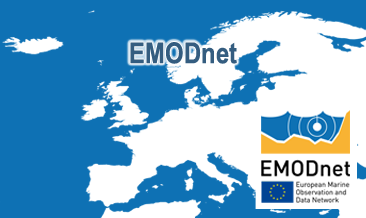Meeresgeologie
Type of resources
Available actions
Topics
INSPIRE themes
Keywords
Contact for the resource
Provided by
Years
Formats
Representation types
status
Service types
Scale
-

Die Daten wurden im Rahmen des KFKI-Projekts "Aufbau von integrierten Modellsystemen zur Analyse der langfristigen Morphodynamik in der Deutschen Bucht (AufMod, Laufzeit 2009-2012)" generiert. Fuer den Bereich der Deutschen Bucht wurden Kornverteilungen ueber eine monotone kubische Spline-Interpolation auf einem 250m-Raster generiert, auf Grundlage der im AufMod-Bodenmodell vorhandenen Datensaetze. Aus den modellierten Kornverteilungen wurden verschiedene sedimentologische Parameter berechnet und klassifizierte Polygone erzeugt. Parameter: - "Median_Grain_Size": Median-Durchmesser (D50) der interpolierten Kornsummenkurve - "Mean_Grain_Size": Mittelwert des Korndurchmessers - "Sorting1": Sortierung nach TRASK: sqrt(D75/D25) - "Sorting2": Sortierung nach Folk and Ward (1957): (phi84-phi16)/4+(phi95-phi5)/6.6 - "Skewness": Schiefe nach Folk and Ward (1957): (phi16+phi84-2phi50)/2(phi84-phi16)+(phi5+phi95-2phi50)/2(phi95-phi5) - "Kurtosis": Kurtosis nach Folk and Ward (1957): (phi95-phi5)/2.44(phi75-phi25) - "GSF_micrometer": Sandfraktionen in 1/2 Phi°-Intervallen, Anteil 63, 2000µm - "PredominantSandFractions": raeumliche Verteilung der Fraktionen die mehr als 50 % des Sediments darstellen, bzw. 20 % - 50 %
-

Verschiedene Kenngroessen zur Beschreibung und Analyse der Morphodynamik in der Deutschen Bucht. Die Daten wurden im Rahmen des KFKI-Projekts "Aufbau von integrierten Modellsystemen zur Analyse der langfristigen Morphodynamik in der Deutschen Bucht (AufMod, Laufzeit 2009- 2012)" generiert. Raeumliche Ausdehnung: Kuestenlinie bis 20m Tiefenlinie. Folgende Parameter (klassifizierte Polygone) beziehen sich auf jaehrliche raumzeitlich interpolierte Tiefen ueber den Zeitraum 1982-2012 (raeumliche Aufloesung: 50m): - "Morphological Alteration": Tiefendifferenzen unterschiedlicher Zeitintervallen (1, 5, 10, 30 Jahre). - "Morphological Space": Zmax-Zmin fuer unterschiedliche Zeitintervalle (5, 10, 30 Jahre). - "Morphological Drive": (dZmax/a)max-(dZmin/a)min; Differenz aus maximaler und minimaler jaehrlicher Aenderung fuer unterschiedliche Zeitintervalle (5, 10, 30 Jahre). Folgende Parameter stellen Analysen der Datengrundlage (Datenbankanalyse) der oben genannten Kenngroessen dar (raeumliche Aufloesung: 250m): - "Count Of Datasets": Anzahl an Vermessungsdaten in der Datenbank fuer unterschiedliche Zeitintervalle (5, 10, 30 Jahre). - "Considered Period": Im Betrachtungszeitraum tatsaechlich mit Vermessungsdaten abgebildeter Zeitintervall. - "minT"/"maxT": Datum des fruehesten/spaetesten Datensatz innerhalb des Betrachtungszeitraums. - "mxTdist"/"minTdist"/"meanTdist": groesster / kleinster / mittlerer zeitlicher Abstand zwischen zwei Datensaetzen innerhalb des Betrachtungszeitraums [Dezimaljahr]. - "maxTds"/"mmaxTde": Startdatum / Enddatum des groessten zeitlichen Abstands zwischen zwei Datensaetzen innerhalb des Betrachtungszeitraums.
-

Jaehrlicher Tiefen ueber den Zeitraum 1982-2012. Klassifizierte Polygone auf Grundlage von raumzeitlichen Interpolationen auf einem Gitter mit einer raeumlichen Aufloesung von 50m. Fuer jeden Jahres-Tiefendatensatz sind 2 Parameter zur Vertrauenswuerdigkeit des interpolierten Tiefenwertes angegeben: Confidence und zeitlicher Abstand zur naechst gelegenen Messkampagne. Die Daten wurden im Rahmen des KFKI-Projekts "Aufbau von integrierten Modellsystemen zur Analyse der langfristigen Morphodynamik in der Deutschen Bucht (AufMod, Laufzeit 2009-2012)" generiert. Raeumliche Ausdehnung: Kuestenlinie bis 20m Tiefenlinie.
-

The European Marine Observation and Data Network (EMODnet) consists of more than 100 organisations assembling marine data, products and metadata to make these fragmented data resources more available to public and private users relying on quality-assured, standardised and harmonised marine data which are interoperable and free of restrictions on use. EMODnet is currently in its fourth phase. BGR participates in the EMODnet Geology theme and is coordinating the “seafloor geology” work package from the beginning. In cooperation with the project partners BGR compiles and harmonises GIS data layers on the topics geomorphology, pre-Quaternary and Quaternary geology and provides those, based on INSPIRE principles, via the EMODnet Geology portal https://www. emodnet-geology.eu/map-viewer/. These map layers present the pre-Quaternary and Quaternary sea-floor geology and Geomorphology of the European Seas, semantically harmonized based on the INSPIRE data specifications including the terms for lithology, age, event environment, event process and geomorphology. The data are compiled from the project partners, the national geological survey organizations of the participating countries. The data set represents the most detailed available data compilation of the European Seas using a multiresolution approach. Data completeness depending on the availability of data and actual mapping campaigns. This open and freely accessible product was made available by the EMODnet Geology project (https://www.emodnet-geology.eu/), implemented by EMODnet Geology Phase IV partners, and funded by the European Commission Directorate General for Maritime Affairs and Fisheries. These data were compiled by BGR from the EMODnet IV Geology partners. All ownership rights of the original data remain with the data originators, who are acknowledged within the attribute values of each map feature.
-
The European Marine Observation and Data Network (EMODnet) consists of more than 100 organisations assembling marine data, products and metadata to make these fragmented data resources more available to public and private users relying on quality-assured, standardised and harmonised marine data which are interoperable and free of restrictions on use. EMODnet is currently in its fourth phase. BGR participates in the EMODnet Geology theme and is coordinating the “seafloor geology” work package from the beginning. In cooperation with the project partners BGR compiles and harmonises GIS data layers on the topics geomorphology, pre-Quaternary and Quaternary geology and provides those, based on INSPIRE principles, via the EMODnet Geology portal https://www.emodnet-geology.eu/map-viewer/. These map layers present the pre-Quaternary and the Quaternary sea-floor geology and Geomorphology of the European Seas, semantically harmonized based on the INSPIRE data specifications for Geology, including the terms for lithology, age, event environment, event process. The data are compiled from the project partners, the national geological survey organizations of the participating countries. The data set represents the most detailed available data compilation of the European Seas using a multi-resolution approach. Data completeness depending on the availability of data and actual mapping campaigns. This open and freely accessible product was made available by the EMODnet Geology project (https://www.emodnet-geology.eu/), implemented by EMODnet Geology Phase IV partners, and funded by the European Commission Directorate General for Maritime Affairs and Fisheries. These data were compiled by BGR from the EMODnet IV Geology partners. All ownership rights of the original data remain with the data originators, who are acknowledged within the attribute values of each map feature.
 Metadata catalogue
Metadata catalogue